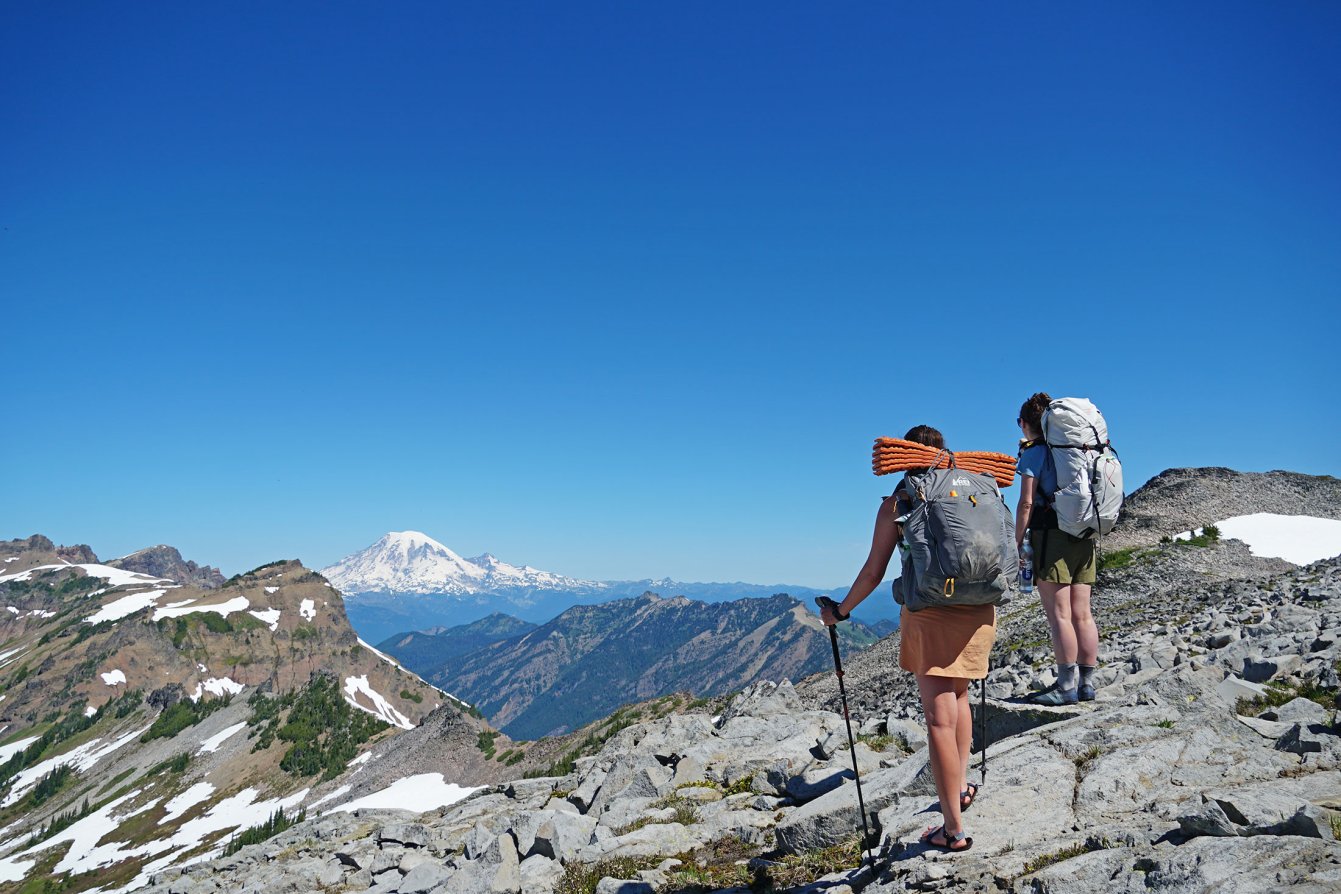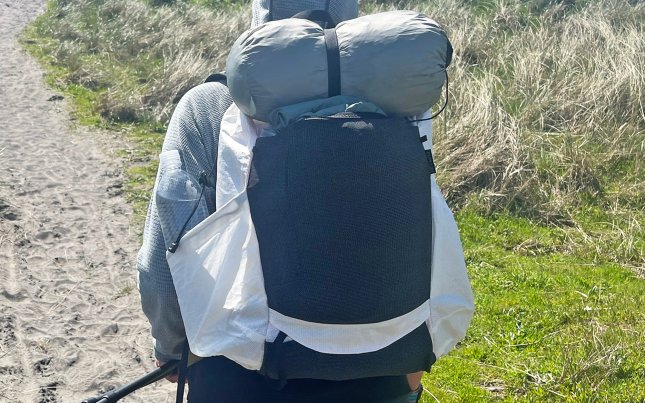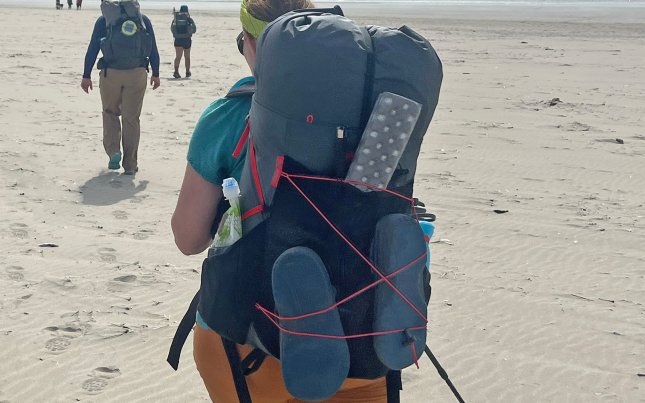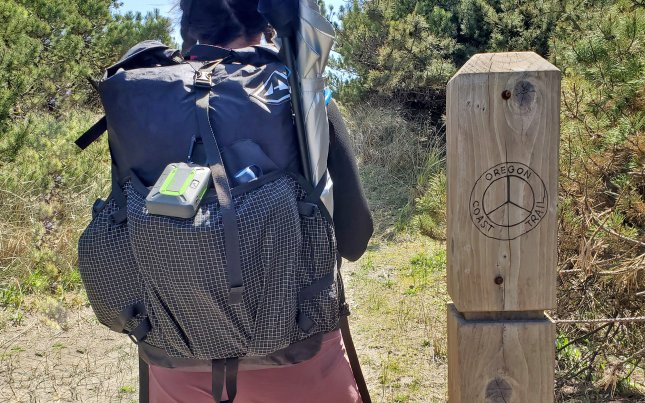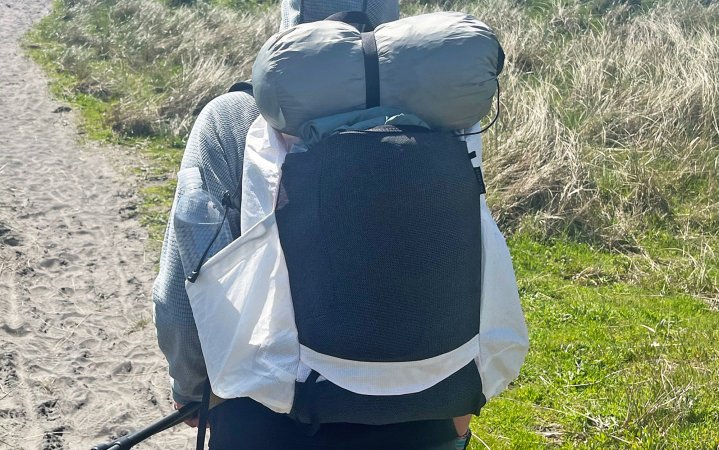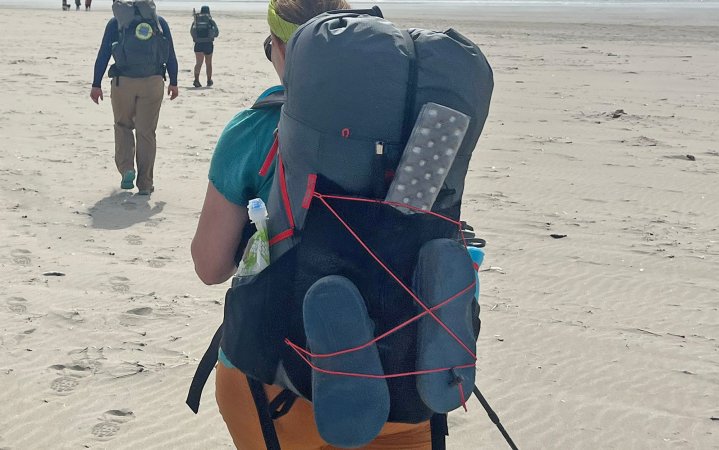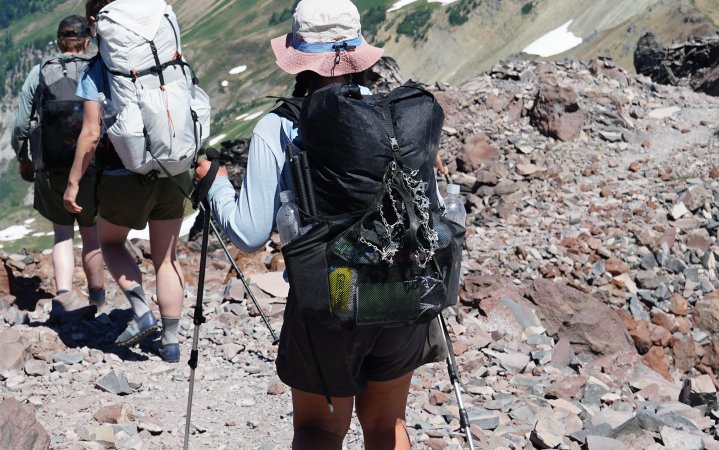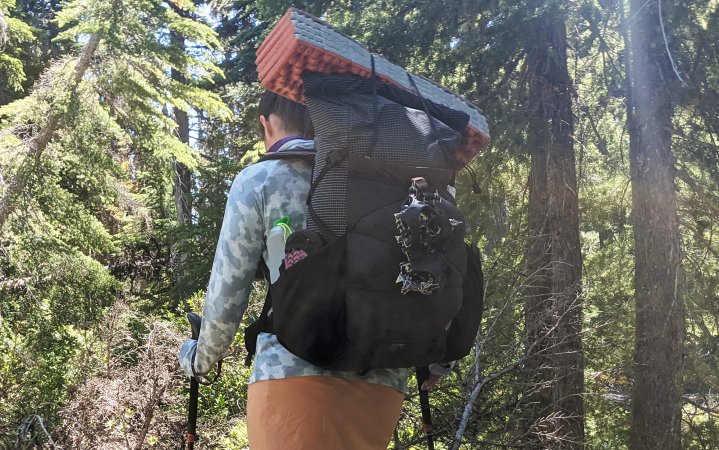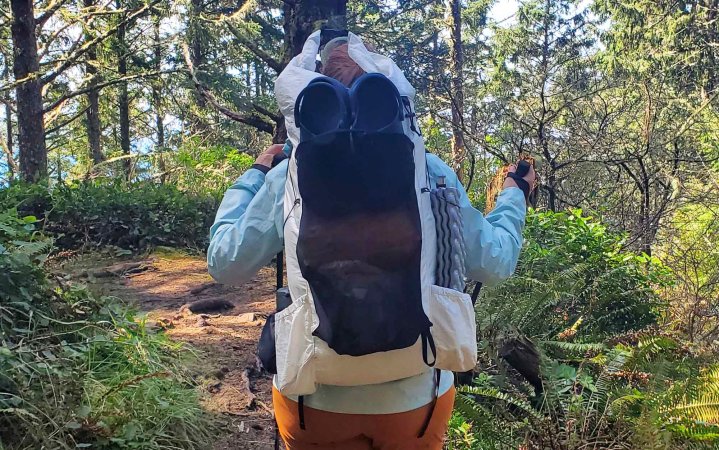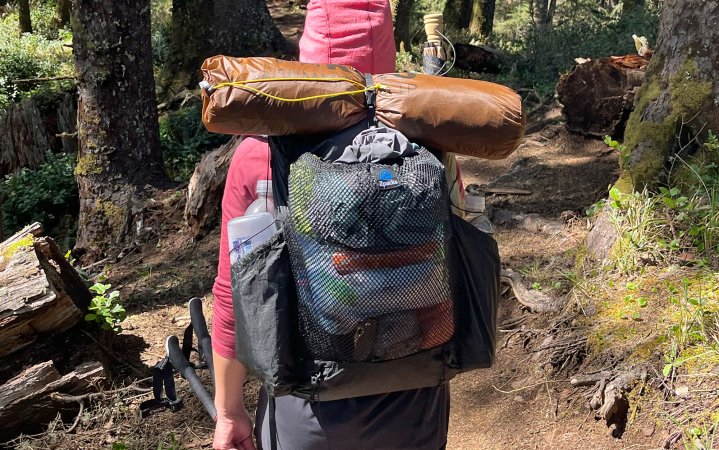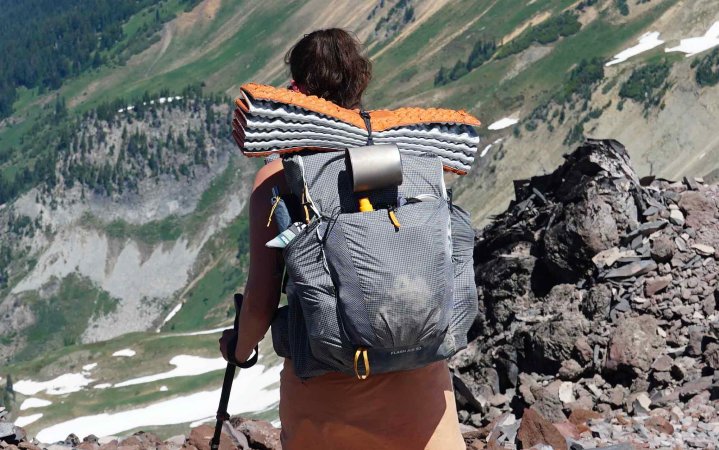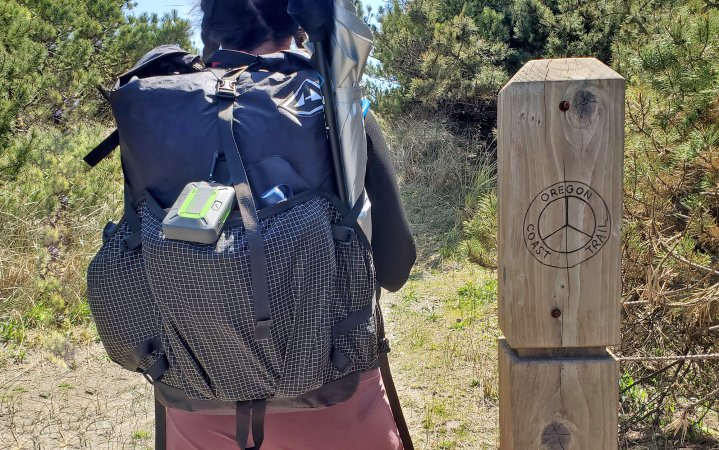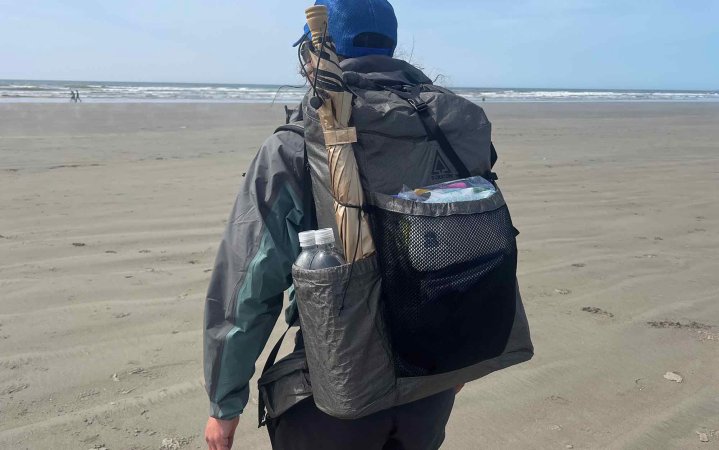We may earn revenue from the products available on this page and participate in affiliate programs. Learn More ›
Ultralight backpackers know that lighter is always better. Whether you are gunning for an FKT or lightening your load before your next thru-hike, choosing a backpack is the most important choice you will make. Outdoor Life has been testing sub 2-pound options as part of our test of the best backpacking gear, working with testers across a range of body types and fit preferences. Over two testing trips on America’s long trails, we’ve checked out backpacks from Zpacks, Palante, Hyperlite, Nashville, REI, Outdoor Vitals, Durston and more.
Like with our take on the best backpacking backpacks, I’ve organized this review by frame type.
- Frameless backpacks, which have no rigid frame structure, typically ride higher than framed backpacks. The waist belt can be used to secure the pack against your torso, but does not transfer weight to your hips. These backpacks typically work best for individuals whose kits are approaching sub-10 pound base weights and/or have strong trapezoids.
- Rigid frame backpacks have aluminum or carbon fiber stays that help move weight from your shoulders to your hips. Unlike other backpacking backpacks, ultralight rigid-frame backpacks typically do not have padding or other support in the back panel.
- Removable frame backpacks allow for users to switch between a rigid-frame backpack stye and a wrap-around style (covered in our take of the best backpacking backpacks), where weight is distributed around the length of the torso.
↓ Best Ultralight Backpacks: Frameless
- Best Overall: Palante Desert
- Best Value: Mountainsmith Zerk
- Nashville Cutaway
- Symbiosis Aspen
↓ Best Ultralight Backpacks: Rigid Frames
↓ Best Ultralight Backpacks: Removable Frames
- Best Overall: Hyperlite Southwest 40
- Durston Kakwa 40
How We Tested the Best Ultralight Backpacks
Selection
While ultralight backpacks were once the sole province of backpackers who had achieved that elusive 10-pound baseweight, today there are ultralight backpacks capable of carrying upwards of 30 pounds comfortably.

We’ve reviewed over a dozen lightweight backpacks as part of our backpacking gear tests, but narrowed it down to the sub-2 pound contenders here.
The Testers
To test the best ultralight backpacks, OL recruited a testing panel with a range of experience levels, body types, and preferences. We had dedicated ultralight backpackers as well as backpackers that regularly carry over 30 pounds test options from Hyperlite, Symbiosis, Nashville, and more.

- Adam Tycaster: Over 4,000 miles of backpacking experience, including the PCT 2014 and CT 2017. Previous go-to backpacks include the Osprey Exos.
- Alex Robinson: OL editor-in-chief; a backcountry big game hunter and fair-weather trail runner. Previous go-to backpacks include the Stone Glacier Evo 3300 and Kuiu Pro 6000.
- Ashley Thess: OL associate gear editor. Over 600 miles of backpacking experience. Previous go-to backpacks include the ULA Ohm.
- Diana Helmuth: Author of How to Suffer Outside (National Outdoor Book Award winner). Over 1,500 miles of backpacking experience. Previous go-to backpacks include the Dana Designs ArcFlex Terraplane.
- Jac “Top Shelf” Mitchel: Over 11,000 miles of backpacking experience including the PCT 2014, CDT 2016, AZT, 2017, and GET 2017. Previous go-to backpacks include the Six Moon Minimalist, Mountain Laurel Designs Burn, and Gossamer G4.
- Laura “Chop Chop” Lancaster: OL staff writer. Over 4,000 miles of backpacking experience, including the PCT 2014 and CT 2017. Previous go-to backpacks include the ULA Catalyst and Osprey Talon.
- Patrice “Steady” La Vigne: Gear reviewer, Denali guide, and author of Between Each Step. Over 7,000 miles of backpacking experience, including the AT 2011 and Te Araroa 2014-2015. Previous go-to backpacks include the Gregory Deva and Osprey Aura.
- Sven “Magic” Anderson: 1,350-mile LASH (PCT) 2022. Hiking with Parkinson’s disease.
Testing
Outdoor Life conducts an annual backpacking gear testing trip that focuses on innovative lightweight and ultralight backpacking gear. These testing trips take place on America’s national scenic trails, including a 30-mile stretch of the northernmost section of the Oregon Coast Trail and a 40-mile stretch along the Pacific Crest Trail in the Goat Rocks Wilderness.

These trips usually see the testing group covering 10 or more miles each day. With our day’s mileage complete we take notes on each pack, as well as the other gear that’s being tested, and then swap out for a different model for the following day. This part can get a little intense as everyone unloads and then reloads all of their gear into a new backpack: think a typical pack explosion, but on steroids and your entire trail family mixing it up. Over time, each pack’s features, flaws, and even personality began to make themselves known — Top Shelf began to see each pack as one of her children.
Scoring
After taking copious notes in the field, the testing team then spends a day filling out scoring sheets for each item in the test. We also discuss and compare with one another, which is helpful for understanding how and why experiences with the same gear can vary from person to person.
Backpacking backpacks are scored on fit, comfort, load bearing, packability, accessibility, and value. Scores are then averaged among the testers.
- Fit: Were the testers able to adjust the pack to fit their bodies?
- Comfort: Did the ultralight backpack produce any hot spots or soreness while hiking? Did they look forward to taking it off or did they leave the backpack on during breaks?
- Load Bearing: We measured how heavy our backpacks were each day before heading out to see how well they handled our typical loads, which ran between 15 and 30 pounds. What makes for great load bearing depends on the style of backpack, with rigid backpacks transferring weight to your hips, and frameless backpacks centering weight high and tight on your traps.
- Packability: We looked at whether we could fit our typical gear kit into each backpack and how easy (or difficult) it was to balance the load.
- Accessibility: How easily could we get at our gear during the day?
- Value: Was the pack worth the price tag for the features it provides?
Comparison Table
Below is a side-by-side look at the specifications most important to ultralight backpackers (price, capacity, and weight) along with the average of our testers’ scores. The backpack weights here come from our testing and, as such, may differ from manufacturer specifications. Prices are current as of the date this article was last updated. Backpacks are organized by frame style and listed in the order in which we recommend them.
Best Ultralight Backpacks: Frameless
| Backpack | Price | Size | Weight | Fit | Comfort | Load Bearing | Packability | Accessibility | Value |
| Palante Desert | $270 | 37 liters | 1 lb, 3.4 oz | 4.5 | 4 | 3 | 5 | 3.5 | 4.5 |
| Mountainsmith Zerk 40 | $220 | 40 liters | 1 lb, 13 oz | 4.5 | 4.5 | 4 | 4 | 4 | 4.5 |
| Nashville Cutaway 40 | $326 | 43 liters | 1 lb, 2.2 oz | 3 | 3 | 2.6 | 3.6 | 3.6 | 2.8 |
| Symbiosis Aspen | $300 | 38 liters | 1 lb, 8.3 oz | 3 | 1.8 | 2 | 3.5 | 1.2 | 3 |
Best Ultralight Backpacks: Rigid Frames
| Backpack | Price | Size | Weight | Fit | Comfort | Load Bearing | Packability | Accessibility | Value |
| Outdoor Vitals CS40 Ultra | $370 | 53 liters | 1 lb, 11 oz | 4 | 4 | 4 | 3.5 | 3.5 | 4 |
| Zpacks Ultra Arc Haul | $400 | 60 liters | 1 lb, 2.2 oz | 3 | 3 | 4 | 3 | 2 | 2 |
| REI Flash Air 50 | $300 | 50 liters | 1 lb, 15.3 oz | 2.5 | 2.5 | 2.8 | 3 | 3.5 | 2.3 |
Best Ultralight Backpacks: Removable Frames
| Backpack | Price | Size | Weight | Fit | Comfort | Load Bearing | Packability | Accessibility | Value |
| Hyperlite Southwest 40 | $350 | 40 liters | 1lb, 14.8 oz | 4 | 4 | 5 | 4 | 4 | 3 |
| Durston Kakwa 40 | $250 | 48 liters | 1 lb, 11.3 oz | 2.5 | 2.5 | 3 | 3 | 4 | 4 |
The Best Ultralight Backpacks: Frameless
Frameless backpacks are one of the most extreme pieces of gear in ultralight backpacking. These packs transfer no load whatsoever to your hips. When they’re working right, they keep the weight high, closer to your trapezoids. Some people — a lot of people — hate this. For one of the frameless backpacks we looked at, a tester commented that it “felt like giving a toddler that wants to kill me a piggyback ride.”
But you also might surprise yourself. I doubt my personal backpacking kit is under ten pounds, even if I swap in an ultralight backpack. But I do have a 45-pound toddler, that I sometimes carry on my shoulders for up to a half mile at a time. When I first tried one of these frameless backpacks, I was surprised by how comfortable — and freeing — they felt compared to the more rigid frames of other models. Being able to move my hips without the constricted feeling of a rigid backpack frame made backpacking more enjoyable (at least as long as my pack weight was under 25 pounds).
In short, if carrying your backpacking kit high on your back supported by your shoulders sounds like hell, skip this entire section and hop down to the removable frames and rigid frames. But if that sounds compelling after years of restrictive framed backpacks, read on.
Best Overall: Palante Desert
Pros
- Surprisingly comfortable
- Very lightweight
- Decent capacity
- Thoughtful details
Cons
- Fewer shoulder strap pockets than other options we looked at
- Limited sizing options
Tested on the Oregon Coast Trail by Jac “Top Shelf” Mitchell and Laura “Chop Chop” Lancaster
Report Card
- Fit: 4.4
- Comfort: 4
- Load bearing: 3
- Packability: 5
- Accessibility: 3.5
- Value: 4.5
Key Features
- Price: $270
- Capacity: 37 liters
- Weight: 1 pound, 3.4 ounces
- Unisex Torso Fit: 17 or 19” (tested the 17” version)
- Pockets: Two side pockets, back mesh pocket, two shoulder strap pockets, one undercarriage pocket
- Adjustment Points: Shoulder straps, sternum strap, waist belt
- Comfortable up to 30 pounds (as reported by the testers)
- Warranty: 2 years
Our most experienced tester, Top Shelf, took the Palante Desert out on the first day of our trek along the Oregon Coast Trail, covering almost 20 miles in an afternoon. She reported that she was surprised at how comfortable she found the backpack, given that its entire weight was resting squarely on her shoulders. But, then again, she was only carrying 14 pounds, which included her typical kit as well as three liters of water. And that’s who frameless backpacks, including the Palante Desert are for, backpackers who have already dialed their base weight down to 10 pounds or less.

While the Palante technically has a waistbelt artfully stashed behind the side pockets, it’s nothing more than wide nylon webbing. This belt does not effectively distribute to your hips — and we don’t recommend trying — it does help to secure the load on your back so that it doesn’t move much side to side while you’re trekking. Our tester reported, as expected, that much of the weight of the pack was sitting on her trapezoids. But she was impressed by the range of motion this style of backpack afforded her. The Palante Desert rides high, even for a frameless backpack, which allows for a more open gait.
Top Shelf liked the thoughtful features designed specifically for this style of backpacking. An undercarriage pouch was the perfect place to stash a bar or two while hiking. Mesh pockets on both shoulder straps fit her phone comfortably. There was even a designated stake pouch in the front mesh pocket. That makes it that much easier to stack your tent against the inside back of your pack — no pointy bits to shift and stab you in the back while hiking. One of the side pockets also ran high, useful for stashing mid-sized gear without having to worry about it falling out. She also noted that the main body of the Palante Desert seemed to swallow gear, holding much more than you would expect given its tiny profile.
I took the Palante Desert out for a four-night trip in Washington State’s Goat Rocks Wilderness — scouting for our second backpacking gear test — and was similarly impressed. The Desert had plenty of space for my kit (which is pretty lightweight but likely not under ten pounds) and four days of food. While I did find the weight on my shoulders starting to get a bit old by the end of the second day, when I did finally pull out the waist strap — this is definitely not a hip belt — it was much more helpful than I had anticipated in distributing the load and taking the weight off my pressure points. By the end of my trek, this backpack looked no bigger than a daypack, and felt about the same as well. I was hooked.

The Palante Desert is available in both 210 gridstop (Dyneema) or 400D Ultra, heavier weight materials than other ultralight backpacks in this test. This should provide substantial durability, and makes the sub 20-ounce weight of the pack that much more impressive. If you’ve been using a frameless (but structured) pack like the Zpacks Arc Haul or the Durston Kakwa 40 for some time and are ready to level up to something even more minimal, this is an excellent choice.
Best Value: Mountainsmith Zerk
Pros
- Affordable (includes lifetime warranty)
- Comfortable
- Great pockets
Cons
- One size fits all may not work for everyone
- Somewhat heavy for a smaller frameless pack
Tested on the Oregon Coast Trail by Patrice “Steady” La Vigne and Diana Helmuth
Report Card
- Fit: 4.5
- Comfort: 4.5
- Load bearing: 4
- Packability: 4
- Accessibility: 4
- Value: 4.5
Key Features
- Price: $220
- Capacity: 40 liters
- Weight: 1 pound, 13 ounces
- Unisex Torso Fit: 16 to 19 inches
- Pockets: Four shoulder strap pockets, four side pockets, one front mesh pocket
- Adjustment Points: Shoulder straps, sternum strap, waist belt
- Comfortable up to 30 pounds (as reported by the testers)
- Warranty: Lifetime
The Mountainsmith Zerk divided our testers. The committed ultralight-pack enthusiasts took one look at the double-mesh pockets, the spongy back panel (the only frameless backpack we’ve looked at to use a piece of foam along the back panel), and thicker nylon body and grabbed something else. It just didn’t have the features they look for in an ultralight backpack.
The other half, who typically wear traditional-style backpacks, picked it up almost immediately. After struggling to pack other ultralight backpacks with little more than a back mesh pocket and a single shoulder pocket, the double pockets on both shoulder straps and both side pockets were a relief. “I was worried that the pack didn’t have hipbelt pockets, but I honestly didn’t need them because there were four side mesh pockets, four chest mesh pockets, and one large mesh pocket plus bungees on the back,” said Steady. “I love pockets and proper organization and there was a place for everything.”

The flexible fabric of the body of the pack was easy to root around in compared to the other packs we looked at and the roll-top closure cinched down tight with one simple buckle. Then we told them that, at $220, it was the lowest priced pack in the entire test. That sealed the deal for the value award.
While the Mountainsmith Zerk is typically targeted at ultralight fastpackers, our testers’ feedback shows that more traditional backpackers looking to experiment with ultralight gear benefit most from this affordable option. The only major downside to this pack is that it has a one-size fits all torso length that will only work for a subset of backpackers.
Nashville Cutaway 40
Pros
- One of the lightest backpacks we’ve ever tested
- Extremely customizable
- Versatile pocket design
- Soft, flexible shoulder straps
Cons
- Uncomfortable when the straps are not positioned optimally
- Not appropriate for a new ultralight backpacker
Tested in the Goat Rocks Wilderness by Adam Tycaster, Alex Robinson, Laura “Chop Chop” Lancaster, Jac “Top Shelf” Mitchell, and Ashley Thess
Report Card
- Fit: 3
- Comfort: 3
- Load bearing: 2.6
- Packability: 3.6
- Accessibility: 3.6
- Value: 2.8
Key Features
- Price: $326
- Capacity: 43 liters
- Weight: 1 pound, 2.2 ounces
- Unisex Torso Fit: 16 to 20 inches
- Pockets: Six shoulder strap pockets, two side pockets, one front mesh pocket with internal shelf, one undercarriage pocket
- Adjustment Points: Shoulder straps, sternum strap, waist belt
- Comfortable up to 25 pounds (as reported by the testers)
- Warranty: 1 year
- Shoulder straps sold separately
The Nashville Cutaway is one of the most challenging backpacks we’ve tested at Outdoor Life. The customization is unparalleled, which presented unexpected challenges during testing. But while not everyone had a positive experience with the Nashville Cutaway, they all respected what this backpack was trying to do.

The biggest difference between the Nashville Cutaway and other ultralight backpacks is that you have full control over the placement of the shoulder straps and sternum straps. In fact, Nashville Cutaway sells them separately so they will arrive in the mail unattached.
Threading the nylon straps through the six buckles (three on each side) is reasonably time-consuming, especially considering they were chosen to be lightweight and strong — not easy to use. I took the liberty of doing this at home before heading out with the team on the initial backpacking gear test, since I was the first person slated to test this backpack.

I’m glad I did. There is always a lot going on during gear testing trips, which can make it hard to give more complex pieces of gear the attention they deserve. But even so, as I hiked, I started to realize that I might not have adjusted the shoulder straps as well as I could. I ended up unraveling all of them during a break and pulling them in a loop on each side. That improved the carry experience substantially, but I could tell by the end of my testing day that I still hadn’t cracked it. Perhaps even one more loop in, and the furthermost in straps loosened, would have done it. But then it was the end of the day, and the pack went to the next tester, Thess.
Thess left the straps, both the shoulder straps and the three sternum straps, as they were when she received the pack. To say she was not a fan, would be an understatement — she rated the pack a 2 for fit and ended up swapping out midday with Magic (he rated it a 3). He also did not adjust the straps. The tester on the third day — Top Shelf — the most experienced in our group — did not adjust the straps and rated the fit as a 3.

On the final day of our trip, I decided to really curate the experience of the tester, Tycaster, adjusting the straps and packing the backpack, which ended up weighing 20.6 pounds. At 13 miles, it was the longest day of our trip, but he still rated it a 4 for fit and a 4 for comfort. “I expected to have to readjust constantly since my other favorite is the Osprey,” Tycaster said. Osprey’s Exos backpack, which we covered in our take on the best backpacking backpacks, has excellent suspension that moves the weight straight to your hips. “However, since I had help, I barely registered it while hiking. If I had sat with it, I could make this fit perfectly.”
“The Nashville needs you to spend quality time thoughtfully configuring its many customizable options to your specific form,” noted Top Shelf. “Your kit needs to be dialed down to 25 pounds or less, including food and water, to allow this pak a fair shot to do what it’s really good at.” OL backpacking gear testing strives to hit a balance between giving the testers’ enough time to get to know and use a lot of different gear and actually backpacking. In this case, the testers simply needed more time than was allotted to go through the trial and error process of optimizing it to their frame. To some ultralight backpackers, this level of customization will sound like a dream; to others, it’s a hassle not worth the trouble.
All frameless backpacks look and feel a bit like shapeless lumps before you start (carefully) organizing your gear inside, but this was especially true with the Nashville Cutaway. That’s in large part due to the fabric used here — Challenge’s EPX70 RS — which is less stiff than the UHMWPE fabric used on the Palante and Symbiosis packs. The pockets on the Nashville Cutaway were also unique, even among frameless backpacks. Like the Palante and Symbiosis backpack, it had an undercarriage pocket, although here the entry point was next to the back rather than along the side.

Each shoulder strap had three pockets, for a total of six, including one with a bottom up-entry. Interestingly, the back pocket was not separated from the side pockets. This presented some frustration among testers, as the lack of structure meant that their water bottles or trekking poles kept falling over to the side. One innovation that was appreciated was the inclusion of a shelf inside the mesh back pocket. This was handy to keep track of smaller items that all too often fall to the bottom of typical back pockets.
Symbiosis Aspen
Pros
- Plenty of capacity in the high roll-top
- Keeps weight centered on your shoulders
- Extreme S-shape of the shoulder straps was comfortable to testers
- Lots of placement options for the sternum strap
Cons
- Smaller capacity than most testers needed
- Tight back mesh pocket was difficult to use
- Only one shoulder strap pocket
Tested in the Goat Rocks Wilderness by Laura “Chop Chop” Lancaster, Patrice “Steady” La Vigne, Diana Helmuth, and Ashley Thess
Report Card
- Fit: 3
- Comfort: 1.8
- Load bearing: 2
- Packability: 3.5
- Accessibility: 1.2
- Value: 3
Key Features
- Price: $300
- Capacity: 38 liters
- Weight: 1 pound, 8.3 ounces
- Unisex Torso Fit: 16 inches to 19 inches (as reported by testers)
- Pockets: One shoulder strap pocket, two side pockets, one front mesh pocket, undercarriage pocket
- Adjustment Points: Shoulder straps, sternum strap, waist belt
- Comfortable up to 20 pounds (as reported by the testers)
- Warranty: Limited lifetime
When they first got their start, frameless backpacks were most popular among a particular type of tall and skinny fastpacking men. Perhaps this was in part because women are more comfortable carrying weight on their hips; perhaps it’s because a lot of extreme ultralight trends get their start among a particular type of tall and skinny fastpacking men. No matter: lighter gear is essential for packing in the high mileage days that thru-hikers encounter, and frameless backpacks are here to stay for good reason.
The problem has been that a lot of frameless backpacks are unisex, which typically means that they don’t fit women — especially curvy women — as well as they do individuals with more streamlined torsos. Symbiosis founder Sarah Berkeley (trail name “Mellow”) struggled to find a frameless backpack that was comfortable to her frame, and was inspired to create a more versatile frameless backpack that was comfortable for individuals with short torsos and large cup sizes. I was especially curious to see if the Aspen Symbiosis appealed to any of the women testers that have heretofore been more skeptical of frameless backpacks.

Results were somewhat mixed. While testers (all women) who wore both this backpack and the Nashville Cutaway, found this pack to be more comfortable, it still didn’t succeed in selling them on the concept of a frameless backpack. First the good, we had a range of sizes and body types use this pack and it fit everyone. The extreme S shape on the shoulder straps fit comfortably around testers’ chests. The ability to move the sternum strap up and down the length of the shoulder straps was highly appreciated by testers.

The Symbiosis Aspen also does a great job of riding high on the torso, which is the most comfortable way to carry weight with frameless backpacks. The only ding here was that our tallest tester, Helmuth, found that she benefited less from the extreme S shape of shoulder straps than other testers simply because she had to let more of the nylon strap out.
But here’s the thing about this backpack: If you find carrying the weight of your backpack on your shoulders uncomfortable, the design tweaks of this backpack are not going to change your mind. “Carrying the weight on my shoulders made me angry,” said one tester. Even knowing how this pack was meant to work didn’t sway everyone, with multiple expressing frustration in their notes at the lack of load lifters and the non-weight bearing waist belt. Reading these notes, it was clear that backpack design isn’t the only reason you’re less likely to see women wearing frameless backpacks in the backcountry: smaller trapezoid muscles mean that women are less likely to find the freedom of motion worth the loss of load bearing potential.

Testers also noted that the interior volume of this backpack was much less than other frameless backpacks. If your kit is ultralight but bulky, this may present an issue. Another struggle was the stretch along the back mesh pocket, which was minimal. Multiple testers noted that it was difficult to reach inside and find things in this pocket, which is a bigger issue for a minimal pack than for a more traditional model with a wider variety of pockets. A bright spot was the top compression strap, which was both extremely long (ideal for something like a closed-cell foam pad or even an empty bear canister) and a pleasure to use.
Best Ultralight Backpacks: Rigid Frames
Outdoor Vitals CS40 Ultra
Pros
- Great back panel padding and ventilation
- Roomy back mesh pocket
Cons
- Expensive
- Profile is somewhat slack
- Aggressive J straps were less comfortable for our testers
Tested on the Oregon Coast Trail by Laura “Chop Chop” Lancaster and Patrice “Steady” La Vigne
Report Card
- Fit: 4
- Comfort: 4
- Load bearing: 4
- Packability: 3.5
- Accessibility: 3.5
- Value: 4
Key Features
- Price: $370
- Capacity: 53 liters
- Weight: 1 pound, 11 ounces
- Unisex Torso Fit: 18 to 22 inches
- Pockets: two hip belt pockets, two side pockets, back mesh pocket
- Adjustment Points: hip belt, shoulder straps, load lifters, sternum strap
- Comfortable up to 30 pounds (as reported by the testers)
- Warranty: Lifetime
There are a lot of positives about the Outdoor Vitals CS40 Ultra. It’s lightweight, thanks in part to its 200D Ultra exterior. It has a great front mesh pocket that not only holds all of your small items, but also allows you to see where they are — decidedly not the case for all the mesh pockets we looked at. It’s got plenty of capacity and it carries loads reasonably well, producing only a minor crick in one tester’s shoulder after 10 miles and 1,200 feet of elevation gain through muddy terrain.
But where this pack really stood apart from the crowd was in its ability to manage sweat along the shoulder straps and back panel. Traditionally, the sweatiest long-distance hikers have gravitated toward Osprey’s packs, including the 40-ounce Exos, because of its best-in-class back panel ventilation. And this isn’t a small point: For some backpackers, back panel chafe can be a debilitating, hike-ending issue. That makes the vast majority of ultralight backpacks a virtual nonstarter.

Steady (who says she sweats “just by looking at the sun”) took this pack out on day three of the Oregon Coast Trail, when temperatures climbed into the upper 70s right as we hit a destroyed section of trail that necessitated some bushwhacking. Not only did she find the back panel to be the most comfortable of everything she tried, but she also didn’t feel any sweat against her back. That’s because, in addition to being ventilated, the padding is also raised off the middle portion of the Outdoor Vitals CS40 Ultra, and overlaid with a mesh layer that allows some airflow to move beneath it. If you’re used to using an Osprey pack, you might be disappointed with the level of airflow provided, but if you are looking for an upgrade from a typical ultralight backpack, this is a massive improvement.
The biggest ding against the Outdoor Vitals CS40 Ultra is that it looks a little sloppy. The mesh of the front pocket is a bit loose, the roll-top bunched up, the side pockets drooped. While this is ultimately more an aesthetic concern than a practical one, at this price point we’d expect a backpack to look a lot sharper. For this testing group — all women — the aggressive J-straps also proved noticeably less comfortable than other models we tested. If your chest has any bulk to it, check out the Duston Kakwa 40.
Zpacks Arc Haul Ultra 40
Pros
- Very lightweight
- Great load bearing
- Fits well
Cons
- Expensive
- Fewest pockets in our test
Tested on the Oregon Coast Trail by Jac “Top Shelf” Mitchell and Ashley Thess
Report Card
- Fit: 3
- Comfort: 3
- Load bearing: 4
- Packability: 3
- Accessibility: 2
- Value: 2
Key Features
- Price: $400
- Capacity: 60 liters
- Weight: 1 pound, 2.8 ounces
- Available Torso Sizes: 16 to 26 inches
- Pockets: Two side pockets, back mesh pocket
- Adjustment Points: Hip belt, shoulder straps, load lifters, sternum strap
- Warranty: Two years
The Zpacks Arc Haul Ultra is exactly what it promises: It strips away everything you don’t absolutely need and uses the absolute lightest materials for everything else. And it does that while staying true to the needs of thru-hikers: It does not skimp on load bearing, boasting both load lifter straps and carbon fiber stays that provide significant structure to this pack.
It does, however, skimp on features — too much, it turned out, for our testers. We should also note that it’s one of the most expensive we’ve ever tested. But it’s also one of the lightest packs we’ve ever tested.

Both of the testers for this pack were impressed with how well the Zpacks Ultra Arc Haul handled the loads typical of ultralight backpackers, thanks in part to the stiff back panel that helped to distribute weight. They even pushed the weight to 26 pounds by strapping a water bladder to the pack during a dry section of the hike. The tester who hauled that load noted that the Zpacks Ultra Arc Haul handled the additional pounds well given how unideal the setup was. And the adjustments were comfortable and conformed to the testers’ bodies the way they wanted them to. This is, after all, an ultralight backpack’s most important job, and the Zpacks Ultra Arc Haul gets it done.
So what didn’t they like? Both testers struggled with accessibility with the Zpacks Ultra Arc Haul, even compared to similar models like the Durston Kakwa 40 and the Palante Desert. There were no pockets on the hip belts, or on the shoulder straps (Zpacks does sell these as fairly pricey additional add-ons), so to get anything out of their packs they had to stop to take it off. They also had durability concerns with some of the non-Ultra parts of the pack — particularly the mesh on the front pocket.
REI Flash Air 50
Pros
- Under two pound backpack
- Great water bottle pockets
Cons
- Stiff, inflexible frame
- Doesn’t carry heavy loads well
Tested in the Goat Rocks Wilderness by Adam Tycaster, Ashley Thess, Jac “Top Shelf” Mitchell, and Sven “Magic” Anderson
Report Card
- Fit: 2.5
- Comfort: 2.5
- Load Bearing: 2.75
- Packability: 3
- Accessibility: 3.5
- Value: 2.25
Key Features
- Capacity: 50 liters
- Weight: 1 pound, 15.3 ounces
- Men’s Torso Fit: 18 to 20 inches
- Women’s Torso Fit: 16 to 18 inches
- Pockets: Two side stretch pockets, front pocket (not mesh), two hip belt zip pockets, one shoulder strap pockets
- Adjustment Points: Attached hip belt, shoulder straps, load lifters, sternum strap
- Comfortable up to 25 pounds (as reported by the testers)
- Warranty: 1 year
Testers were surprised at the end of the test when I revealed both the weight and the price point of the REI Flash Air 50. At just under two pounds, it was right in line with the likes of the Hyperlite Southwest. But it was more expensive than testers, accustomed to REI as a best-in-class value brand, were expecting. And ultimately, given the quality of other options on this list, they didn’t think that the weight savings were justified by the pack’s design at this price point.
Unlike other packs, testers reported a myriad of small complaints with this pack with no clear pattern. Magic reported that it didn’t move with his body like other backpacks at this weight typically do, while Top Shelf and Thess said that the frame felt stiff and inflexible. Thess even commented that she struggled with portions of the frame digging into her torso, while there was a general consensus that the pack didn’t carry well even with sub-30-pound loads. Top Shelf also noted that the laminate being used tended to be a bit sticky in humid weather.
Two bright spots with the REI Flash air was the inclusion of separate water bottle compartments that was a boon for individuals that don’t use hydration bladders. Testers also noted that the hip belt on the REI Flash Air was especially comfortable, with one tester noting that if you could swap these two features onto the Osprey Exos, you’d have the perfect backpack. Magic also said that the easy-to-access water bottle pockets were a game change for his Parkinson’s.
I was a bit surprised at how little the testers responded to the REI Flash Air 50. It has many popular features: roll-top lid, deep pockets at the side and back, a Y-strap that can be used to secure additional gear on top of the pack, shoulder strap pocket. But when the group sat down to go through the packs, there was little to say about the REI Air Flash 50 compared to other packs that elicited strong feelings in either direction. In the end, I wonder if it was this unexpected marriage of features: a backpack that presented and weighed-in as ultralight but then tried to carry like a traditional backpack that just didn’t sit right, leaving the testers feeling that this backpack simply wasn’t for them even if there wasn’t anything all that wrong with it.
Best Ultralight Backpacks: Removable Frames
Best Overall: Hyperlite Southwest 40
Pros
- Available in brick and mortar stores
- Lightweight
- Great load bearing for its weight
Cons
- Expensive
- Sternum strap was abrasive to our tester
- Limited warranty
Tested on the Oregon Coast Trail by Ashley Thess with additional input from Jac “Top Shelf” Mitchell
Report Card
- Fit: 4
- Comfort: 4
- Load bearing: 5
- Packability: 4
- Accessibility: 4
- Value: 3
Key Features
- Price: $350
- Capacity: 40 liters
- Weight: 1 pound, 14.8 ounces (1 pound, 15.9 ounces for DCH150)
- Unisex Torso Sizes: XS to L (15 to 21 inches)
- Pockets: Two hip belt pockets, two side pockets, one large back pocket
- Adjustment Points: Hip belt, shoulder straps, sternum strap
- Comfortable up to 25 pounds
- Warranty: One year
Hyperlite is one of the most well-known names in ultralight gear, and it’s one of the few sold in brick-and-mortar stores. So we were curious to see how it would stack up next to the cottage companies. If you try out a Hyperlite pack in an REI and love it, does that mean you should go ahead and buy it? Or would it be better to take a gamble on another pack in this list?
After testing the Hyperlite Southwest 40, we feel confident that you should trust your gut and buy that Hyperlite if you like it in the store. It’s comfortable even with the heavier end of ultralight loads (one tester carried 24 pounds in this pack over 15 miles). Despite having only two aluminum stays and no load lifters, Thess said she was able to forget about the pack on her shoulders — the highest of praise, in our opinion.
It also scored high for its accessibility, as it had all of the pockets (two hip belt pockets, two side pockets and a giant front pouch held closed with an elastic band) we look for from an ultralight backpack, and none of the ones that add extra weight without increasing functionality.
One thing to note is that, unlike the other ultralight backpacks at this price point, the Hyperlite is made from DCH rather than Ultra. DCH is a laminated version of Dyneema Composite Fabric (DCF), which has many of the same qualities as Ultra. The only concrete difference between the two is that DCH tends to look the worse for wear over time, although its performance is typically unaffected.
So what are the downsides of this pack? It’s a few ounces heavier than the other packs in Ultra that we looked at (although lighter than the more frame-intensive ULA Circuit). Despite their widespread availability and ubiquity, there isn’t the option to switch to S straps (although our tester did note that the J straps were less extreme than on other ultralight backpacks). The sternum strap is also only minimally adjustable, and for Thess it was pitched too high. She reported needing to stash a bandana underneath to prevent chafing. Finally, it has a limited warranty — only one year.
Durston Kakwa 40
Pros
- Great pockets
- The most affordable backpack in Ultra that we looked at
Cons
- Lack of structure along the back panel requires careful packing
Tested on the Oregon Coast Trail by Jac “Top Shelf” Mitchell and Ashley Thess with additional input from Laura “Chop Chop” Lancaster
Report Card
- Fit: 2
- Comfort: 2
- Load bearing: 3
- Packability: 3
- Accessibility: 4
- Value: 4
Key Features
- Price: $250
- Capacity: 36 liters
- Weight: 1 pound, 11.3 ounces
- Unisex Torso Fit: 14.5 to 21.5 inches
- Pockets: Two hip belt pockets, two side pockets with vertical zip pocket on the left side, back mesh pocket
- Adjustment Points: Hip belt, shoulder straps, load lifters, sternum strap
- Comfortable up to 35 pounds (as reported by the testers)
- Warranty: One year
The Durston Kakwa 40 is an experienced ultralight backpacker’s dream. It’s lightweight (27.3 ounces for a medium). It has enough structure to manage heavier loads. It’s got all the pockets you’d expect (plus one extra). It’s made with Ultra, giving you that extra durability and additional waterproofness. And it’s extremely reasonably priced.
While the Durston Kakwa 40 has a frame that’s similar to the ULA Circuit, what it doesn’t have is a foam backing. On most of the back panel, there’s just a thin piece of Ultra fabric between you and the interior contents. Thess struggled with the lack of structure, reporting that a bulge against her back all day was annoying. Like all frameless, or unpadded, backpacks, even slightly less than ideal packing is going to result in serious discomfort. If you’re going frameless for the first time, pay attention to how you’re structuring the items in the Durston Kakwa 40.
Top Shelf, conversely, found the structure to be almost too stiff. While it wasn’t uncomfortable, it was more noticeable than other packs we looked at. After the testing trip, I loaded this pack up with about 35 pounds to see how it would handle the load. (35 pounds is what you should expect to carry in the desert with an all-day water carry but an otherwise ultralight load.) Whereas the pack hugged around my body comfortably at 15 pounds, to get the 35-pound balanced between my hips and my shoulders it had to perch more on my hips that was natural. That would be fine for a short distance (you are going to be drinking all that water, after all); this is not the pack for someone who plans to consistently carry 35 pounds.
The testers appreciated the details of the Durston Kakwa 40. Generous hip belt pockets, side pockets, and front mesh pockets (one of the few in our test that was truly see-through) made stashing items on the go a breeze. There was also a bonus zip pocket along one of the side pockets for easy access to larger items that don’t fit in your side pocket. Our only ding on the features were the side compression straps, which were somewhat difficult to tighten and release.
How to Choose the Best Ultralight Backpack
Frame or Frameless
Most backpacks, even ultralight backpacks, have some kind of internal frame or structure, to support the heavier loads that occasionally occur on long-distance treks by transferring some of the weight to your hips. If you plan to forgo any kind of structure to the back panel of your backpack, then aim to keep the total weight of your backpack below 20 pounds. If you’d like to experiment with going frameless without committing, choose a pack with a removable frame.

Packing Your Bag
Packing an ultralight backpack is different from packing a traditional backpacking backpack. These backpacks are essentially a giant tube — pack something at the bottom that you end up needing in the middle of the day and you’re going to have to unpack your entire backpack to retrieve it.
Backpacks without a rigid back panel add another complication: If you pack something stiff or awkwardly shaped in the wrong spot, it’s going to press into your spine until you stop and rearrange everything. For backpacks that lack back panel support, Top Shelf recommends using a vertical stacking approach (rather than a horizontal one) to give more structure and support to the backpack. Softer items, like the body of a tent, go against the back panel instead of more rigid items, like a cooking pot or food bag. When you’re finished, look at the back panel from the outside and confirm that it has a straight profile before heading out for the day. She noted that an advantage to packing gear into an ultralight backpack is that you typically don’t need to pay as much attention to weight distribution within the backpack, since everything is already lightweight.
Material
The recently released Ultra material has upended the world of ultralight backpacks, and there were a number of backpacks that used this material as their primary body fabric. What makes Ultra unique is its durability and waterproofness (up to 200 PSI) coupled with its low weight. Other popular backpack materials are DCH (a variation of Dyneema) and ripstop nylon (particularly Robic, which is especially tear-resistant). Note that whatever material you choose, the mesh pockets are typically the first part of the backpack to give out.
Fabric thickness is measured in denier, typically shortened to D. Most backpacks we looked at were 200 denier, although some were reinforced or made wholesale out of more robust 400 denier fabric. A few were also thinner; if you choose one of those options, consider the warranty provided and the amount of wear and tear you typically put on your gear.
It has become increasingly common for individuals using packs made entirely or partially from Ultra to forgo rain covers, waterproof pack liners (typically a trash compactor bag), or both. The water resistance of brand-new Ultra is quite high — up to 200 PSI. However, a visual inspection of the ultralight backpacks showed that of the five that used the Ultra material, only one was seam-sealed on the inside (the Zpacks Ultra Arc Haul). When queried, ULA explained that this is because, with enough use, seam sealing will come apart and even the most waterproof material will eventually wet out. In Ultra’s case, this is in part because it gets its water resistance from a lamination: Anywhere on the pack the lamination starts to fail then becomes a potential entry point for water. While Ultra will take on less water weight than other materials, trusting this material to provide long-term protection akin to a dry bag is likely to eventually result in wet gear.
Strap Style
Most ultralight backpacks default to the typical J-strap, rather than the S-strap commonly seen on women’s packs. Our testers (all women) thought they would be bothered by this, but ultimately it wasn’t an issue (at least for most of the packs). There was a preference for the running-vest style straps — which hug your body more than traditional backpacking straps — on the Mountainsmith Zerk and Nashville Cutaway among testers that used those backpacks.
Torso Length
Unlike traditional backpacking backpacks, which often allow you to zero in on the exact torso length for your frame, almost all of the ultralight backpacks we looked at for this test had a fixed torso length. During testing, it was clear that whenever you are in-between sizes (say you have a 17-inch torso length and are trying to decide between a small that fits between 15 to 17 inches and a medium that fits 17 inches to 19 inches) that it’s best to size down. Testers could typically get a slightly too-short torso to work fine, but struggled with backpacks that were too long for their frame.
Warranty
Ultralight backpacks can vary widely in their durability. Some of these packs you could carry for 10,000 miles; others are going to be shredded by the end of your first thru-hike. In our experience, the warranties provided by the manufacturer often reflect what you can expect, with the most durable packs having multi-year or lifetime warranties, while less durable packs will stop at one year. While we did not test for durability during our section hike of the Oregon Coast Trail, we have included warranty information as part of this review, querying manufacturers when their policy was unclear to provide sufficient context for long-distance hikers. Keep in mind that the majority of these warranties will cover repairs to your existing backpack, with full-blown replacements only being provided under select circumstances.
FAQs
The benefits of ultralight backpacking depend on your average mileage. If your backpacking trips typically involve hiking five to ten miles to a mountain lake, then lounging in a hammock with a beer, you will likely be happier with a traditional backpacking backpack, which are designed to carry heavier loads comfortably for short distances. If you’re hoping to knock successive 20- or 30-mile days deep into the backcountry, then an ultralight backpack can help reduce the overall load on your legs and feet.
Forty-five liters is a very comfortable size for most backpacking trips, capable of carrying enough food and water for up to five days at a time. Larger 60- or 75-liter packs are a great choice if you plan to head out for more than a week at a time or if you’ll be carrying gear for more than just yourself. Smaller 30-liter packs are typically used by fastpackers to cover very large daily distances (35+ miles), cutting down on the amount of excess food and water they need to carry a time.
While ultralight backpacking can sometimes feel like a race to the bottom—cutting it down to 15 pounds, then 10, then 5—most experienced ultralight backpackers aren’t overly focused on base weight. Different treks will call for different gear sets, have different water carries, longer or further resupply distances. If you’re new to ultralight backpacking, first check the recommended weight limit for your backpack and compare that to the kit you are planning to carry into the backcountry.
Final Thoughts on the Best Ultralight Backpacks
The best ultralight backpacks we looked at for this test spanned a range of styles and approaches, reflecting the creativity and ingenuity of UL cottage company designers. There were packs lacking load lifters, standard hip belts, and back panel frames and structure. However, without fail, all testers reported that they were able to carry plenty of weight comfortably in these packs. Where ultralight backpacks occasionally stymied us was in their approach to organization and accessibility. Each is unique and you’ll need to develop a personal relationship with it to zero in on the perfect packing strategy. But we’re confident that if you’ve been curious about trying out ultralight backpacking, one of the options on this list will change the way you travel in the backcountry:
Best Ultralight Backpacks: Frameless
- Best Overall: Palante Desert
- Best Value: Mountainsmith Zerk
- Nashville Cutaway
- Symbiosis Aspen
Best Ultralight Backpacks: Rigid Frames
Best Ultralight Backpacks: Removable Frames
- Best Overall: Hyperlite Southwest 40
- Durston Kakwa 40
